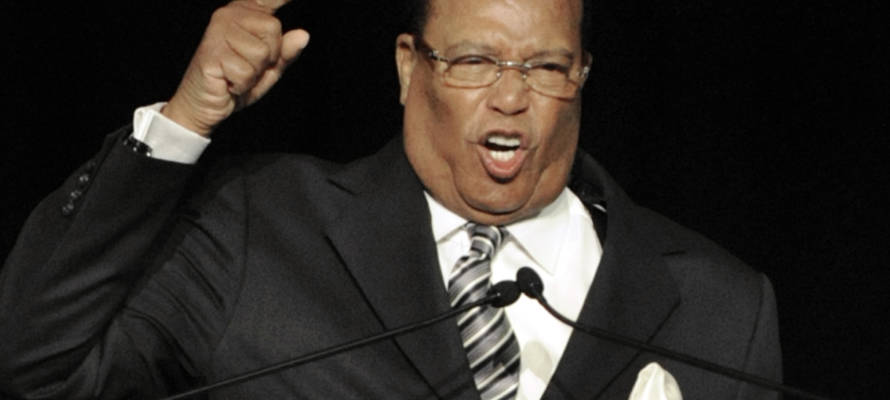The New York Times outdid itself on Sunday with an oped extolling infamous anti-Semite Louis Farrakhan and his enablers. Those who oppose the dissemination of hatred must speak up – before it’s too late!
There’s an old saying that behind every great man is a great woman. Last Sunday, the New York Times published an article celebrating Marion Barry and other women who helped notorious Nation of Islam leader Louis Farrakhan in 1995 with publicity for the Million Man March.
The oped, written by author Natalie Hopkinson, an associate professor at Harvard University, is titled “The Women Behind the Million Man March.” The piece is subtitled: “Behind every great feat in the public record lies an untold story of the unsung foot soldiers.” Further down in the article, she repeats that sentence, adding, “and these are often women.”
Farrakhan is a danger not only to Jews. As noted by the Anti-Defamation League, for decades Farrakhan “has been a notable extremist figure, railing against Jews, white people and the LGBT community.
“In recent years, Farrakhan has embarked on a wide-ranging campaign specifically targeting the Jewish community, a campaign that has featured some of the most hateful speeches of his tenure as head of NOI. Farrakhan has alleged that the Jewish people were responsible for the slave trade and that they conspire to control the government, the media and Hollywood, as well as various black individuals and organizations. He frequently denies the legitimacy of Judaism – or Jewish claim to the land of Israel — arguing that Judaism is nothing more than a ‘deceptive lie’ and a ‘theological error’ promoted by Jews to further their ‘control’ over America’s government and economy.”
In a column published Wednesday by the Jewish Telegraphic Agency, Jonathan Greenblatt, the ADL’s CEO, reminds his readers that the late black civil rights leader and statesman John Lewis “declined the opportunity to speak at the march. He wrote in Newsweek that he could not ‘overlook past statements by Louis Farrakhan — and others associated with the Nation of Islam – which are divisive and bigoted.’ Lewis said that the march was ‘fatally undermined by its chief sponsor.’
“In running this piece,” Greenblatt said, “the Times is guilty of the sin of omission. It failed to make clear that Farrakhan is an avowed bigot, one who may draw applause in some quarters but who has been rejected in mainstream circles for decades because of his unapologetic prejudice.
“Running this piece without any mention of his history only further legitimizes an anti-Semite and hateful figure. In short, excusing his intolerance by overlooking it makes it more acceptable for other leaders to hold such dangerous views.”
Indeed, the promotion of Farrakhan is outright dangerous. As explained in a blog by American-Israeli Rabbi Rashi Rosenzweig, “Many people dismiss Farrakhan as a fringe lunatic — but that is a very dangerous game.
“People need to understand how monumental tragedies such as the Holocaust begin. It is not with ruthless beatings and murder at the outset; their origins are much more subtle. They begin with words; they begin with articles in the local newspaper seasoned with age-old anti-Semitic jargon; the next step is speeches in front of small crowds, which lead to speeches in front of larger crowds. The slow burn of Farrakhan’s hatred is easy to ignore — until it’s too late.”
The late author, human rights activist and Nobel Peace Prize winner Elie Wiesel, a Holocaust survivor, said, “We must always take sides. Neutrality helps the oppressor, never the victim.” We agree. We cannot be silent!
Incidentally, the publication of Hopkinson’s article is not the first time that the American newspaper that enjoys worldwide influence and readership has printed hate-inciting material. Just one example: In April 2019, the Times published a cartoon portraying Prime Minister Benjamin Netanyahu as a dog, with the Jewish Star of David symbol dangling from his collar. Netanyahu’s leash is held by US President Donald Trump, who is depicted as a blind man wearing a skullcap.
Following backlash, the paper tweeted an acknowledgment that the cartoon contained “anti-Semitic tropes” and deleted it. However, it did not unequivocally apologize.
Popular American-Jewish journalist Bari Weiss, author of the award-winning book How to Fight Anti-Semitism and a self-described “proud Jew” who resigned from the Times in July, tweeted:
“Today the New York Times ran an oped about the Million Man March and Louis Farrakhan. If you read the oped and new nothing about Farrakhan, you would think he was a gentleman.”
Today the New York Times ran an oped about the Million Man March and Louis Farrakhan. If you read the oped and knew nothing about Farrakhan, you would think he was a gentleman. (Thread) https://t.co/5ZhTMDypHQ
— Bari Weiss (@bariweiss) October 18, 2020
Send your own message to the New York Times at letters@nytimes.com, inyletters@nytimes.com, or editorial@nytimes.com, telling them that glorifying Farrakhan and his enablers is unacceptable and downright dangerous. Or use this template:
Dear editor, I am writing to express my dismay that the New York Times would publish an article glorifying notorious anti-Semite Louis Farrakhan and the women who helped him promote the Million Man March. Farrakhan is a dangerous man, and his hatred is aimed not only at Jews. This message is in reference to the Oct. 17, 2020 oped titled: “Behind every great feat in the public record lies an untold story of the unsung foot soldiers.” You have crossed the line! That a respected, influential newspaper would publish such an oped will only embolden anti-Semites, racists and others promoting a vicious agenda.
